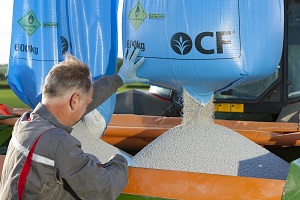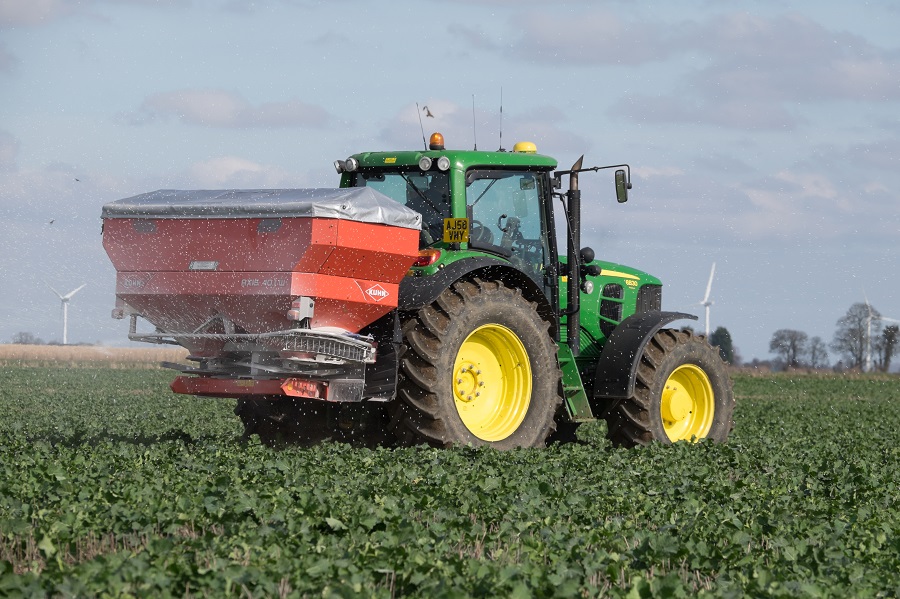Good oilseed rape establishment and a strong market could mean things are looking up for growers who kept their faith in the crop. CPM gets advice on matching fertiliser inputs to crop potential this spring.
It’s always easier to manage a big crop backwards.
By Rob Jones and Lucy de la Pasture
In spite of its performance last season, many growers stuck with oilseed rape last autumn. According to the AHDB Early Bird Survey, 312kha went into the ground – a reduction in area of around 18%. But with many crops well established, those that have stuck with OSR have reason to be confident they made the right decision, says Mark Garrett of CF Fertilisers.
“Prices are at a high level and most people will have strong proven OSR varieties in the ground. Genetic development hasn’t slowed down despite the problems many growers have had with cabbage stem flea beetle, so it’s still a high potential crop. It’s likely the lower volumes now being grown will mean output demand will remain strong,” he says.
Once crops have got through the winter, nutrition is one of the main areas where growers can really make sure they benefit from the crop’s full genetic potential. The first step is to understand the nitrogen likely to be supplied to the crop by the soil, he suggests.

Sulphur application in early spring has been shown to consistently provide yield benefits, especially after a wet winter when soil supplies leach away.
“Knowing the soil nitrogen supply (SNS) enables you to calculate how much nitrogen fertiliser to apply and the most accurate way of doing this is to use the CF N-Min test. This will give a much more accurate picture than simply looking at soil mineral nitrogen (SMN) which doesn’t take nitrogen that’ll become available from the soil as the season develops into account, and this is key to getting application rates right,” he explains.
“It’s also important to manage the size of the crop to build the most efficient canopy possible. The amount of nitrogen applied per application depends on the canopy size after winter. Applying smaller, more frequent applications can be helpful in building up the canopy of a backward crop but you don’t want a canopy that’s too big,” he says.
“A larger crop is prone to more agronomic problems and is generally less efficient at intercepting light needed to produce the higher yields. That said, it’s always easier to manage a big crop backwards than a smaller one forwards.”
CF’s N-Calc system helps calculate the fertiliser nitrogen required to deliver as close to the target yield as possible. The total nitrogen recommendation is usually best split into up to three fertiliser applications, with at least the first containing sulphur, to address the crops need, adds Mark.
He highlights trials at Rothamsted Research’s Woburn site which have shown OSR yields from untreated plots were half that of crops which received sulphur. “The trials revealed a yield of just 2.5t/ha without sulphur and 5.0t/ha where appropriate fertiliser applications were made. Further trials went on to show an average yield benefit on responsive sites of 27%.
“AHDB work, carried out by ADAS and in conjunction with industry partners including CF Fertilisers, has also shown the benefit of sulphur application. A lift in OSR yields from 1.0t/ha (untreated) to 5.0t/ha was recorded at one site and to a similarly high level from about 1.5t/ha at another.
“In addition, the sulphur was also found to significantly improve oil content – with a lift from 39% to 45% at one site and from 42% to 45% at the other,” he adds.
Yield responses to sulphur will vary depending on existing deficiency levels, soil type and crop, explains Mark. “Deposition of sulphur to the soil from the atmosphere has fallen by over 90% in the last few decades, with lighter soils in areas of high rainfall especially susceptible to deficiency.
“Sulphate, the form of sulphur taken up by crops, is soluble in water just like nitrate and can leach out of soils. Deep silty or clay soils are less vulnerable but, in most cases, these still require additional sulphur to protect OSR yields and seed quality. It’s now widely accepted that where deficiency is evident, the effects of sulphur applications are considerable.”
A grower’s perspective
Monitoring soil nitrogen resources, together with optimising fertiliser application rates and timings, has helped a Cheshire producer save £65/ha on fertiliser costs last year without sacrificing OSR yield.
Rob Briscoe’s crop performed to its ten-year yield average (4.2t/ha) with an oil content of 44%, despite cutting back the usual application of over 200kgN/ha to just 112kgN/ha – resulting in a margin over fertiliser costs of over £1400/ha.
“It was sometimes a bit nerve-racking to think we had cut back so much, and at times we were tempted to put a bit more on, but in truth the crop looked good all the way through,” he says. “So we decided to put our faith in science, base our applications on what the soil testing and crop growth was telling us and follow the canopy management application approach recommended.”
His 20ha of Django was grown with a min-till approach using discs to prepare the land, and then sown on 19 August at 3.5kg/ha using an Amazone combination drill. He applied 123kg/ha DAP to the seedbed, which was then Cambridge-rolled.
“A pre-emergence herbicide was applied, followed by fungicide in November. A further fungicide, PGR and foliar nutrition tank-mix was applied in March, followed by another fungicide and foliar nutrition application in May.”
The N-Min sample was taken on 13 February and this concluded that there was 83kgN/ha available from the soil. The Green Area Index was estimated at 2.0, which suggested 100kgN/ha had already been taken up by the plant, giving a total SNS of 183kgN/ha.”
CF’s N-Calc system was then used to calculate the nitrogen fertilizer required to deliver as close to a 5.0t/ha crop as possible, he says.
“The recommendation was for 100kgN/ha and this was divided into three splits, with DoubleTop being used first.”
The final yield achieved was close to the crop average for the farm but with less nitrogen applied, he points out. “You have to be realistic – we have very light soils here. The big point for me is we would have applied the same 200kgN/ha as usual had we not had the N-Min result.
“The carryover of N from that last winter was sizeable and all our N-Mins were high, as none of the previous wheat crops had done particularly well and the winter was dry so the nitrogen remained in the soil.
“At the end of the day we saved around £65/ha in fertiliser costs, achieved the same yield results as previous years and now understand a lot more about how we approach our nutrient needs moving forward.”
Innovative soil tests launched
Eurofins Agro has launched a new approach to soil testing which utilises some innovative analytical technologies which mean physical, chemical and biological information can be obtained from just two techniques. The tests will help farmers and agronomists understand soil in a more detailed way than ever before, explains Dan Robinson, managing director at Eurofins Agro UK.
“Three new products are now available – Fertilisation Manager, Soil Crop Monitor and Soil Life Monitor – which offer the most comprehensive way to analyse and improve soil health,” he says.
Eurofins has taken the concept of nutrient intensity and nutrient quantity, which is well recognised in academic literature. Using the 0.01M calcium chloride as the extraction agent method (1:10 W/V dried soil), it’s possible to determine the plant available nutrients (or nutrient intensity).
Near Infra-Red (NIR) technology is then used to determine soil fertility by measuring the soil nutrient supply capacity (quantity and buffering) in dried soil – this reflects the soils ability to maintain nutrient intensity as the nutrient is depleted.
These new techniques have undergone a novel calibration process using machine learning, which has now been comprehensively validated, adds Dan. It means that with just two tests, growers can obtain a holistic overview of soil health and fertility.
Fertilisation Manager measures soil fertility. “This includes the chemical values of macro and micronutrients. Soil pH and the overall structure of the soil are also analysed in conjunction with biological components such as fungi and bacteria,” he adds.
Soil Crop Monitor will provide the most accurate means of testing soil during a growing season. “Unlike some tests, Soil Crop Monitor analyses both the soil and the plant, measuring the plant available nutrients and the nutrients absorbed by the crop.”
Soil Life Monitor determines the total microbial biomass, fungi, bacteria and protozoa. “The microbial biomass from the sample will help farmers to understand the sensitivity of the soil to conventional farming methods, such as ploughing which is thought to disturb soil microbial communities. The number and nature of the bacteria present in a soil sample will also facilitate the accurate calculation of nutrients which should be added to the soil to optimise plant health and growth,” he says.
It also identifies some physical characteristics such as pH and the quality of organic matter. “PLFA (phospholipid fatty acids) found in soil can be measured to provide a fingerprint of the soil content. PLFAs are degraded quickly in the soil, so the analysis gives an indication of the amount of living biomass,” explains Dan.
“NIR also enables the measurement of soil organic carbon (SOC) which gives an insight into soil quality – the more SOC, the more stable the soil. When SOC is low, then nitrogen, phosphate and sulphur are higher giving a more dynamic soil due to the mineralisation taking place.




